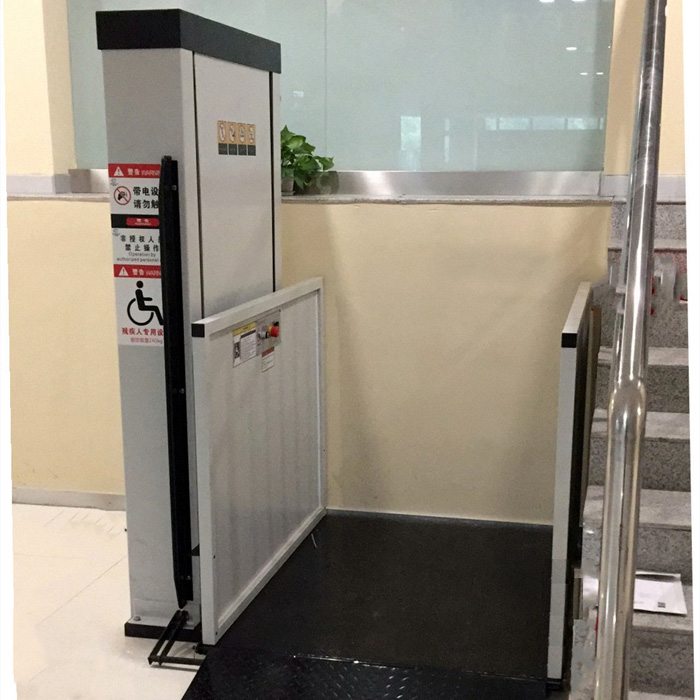
Vertical Platform Lifts
For individuals with mobility limitations, moving between different floor levels can be a daily struggle—one that vertical platform lifts (VPLs) are designed to ease. Unlike traditional elevators that demand significant space and installation effort, VPLs are built to be flexible, practical, and tailored to real – life needs. From narrow home hallways to busy public spaces, these lifts turn once – inaccessible areas into usable ones, focusing on simplicity and reliability for all users.
Space – Saving Design for Tight Environments
One of the biggest hurdles in adding mobility solutions to existing spaces is limited room—and VPLs excel at addressing this. Unlike elevators that require dedicated shafts or large enclosures, VPLs have a compact footprint that fits into narrow gaps. For example, in a home with a narrow staircase, a VPL can be installed along the side of the stairs, taking up only a few feet of width. This means homeowners don’t have to sacrifice living space or rearrange furniture to accommodate the lift.
Even in public spaces with crowded layouts, like small cafes with a mezzanine or local libraries with split – level floors, VPLs can be placed in unused corners or next to stairwells. Some models are even designed to be “semi – portable”—while not fully movable, they can be installed without permanent structural changes, making them ideal for rental spaces or buildings where renovations are restricted. This space efficiency makes VPLs a top choice for environments where traditional lifts simply won’t fit.
Customized Solutions for Special Scenarios
VPLs aren’t one – size – fits – all—they can be customized to meet unique user needs and environment requirements. For users with large wheelchairs or mobility scooters, manufacturers offer extra – wide platforms (up to 48 inches in some cases) that provide enough room to maneuver safely. For those with limited hand dexterity, control panels can be modified with larger buttons, touchless sensors, or even foot – operated controls, eliminating the need for fine motor skills.
Outdoor scenarios demand additional customization, too. VPLs installed in areas with heavy rain or snow come with weather – tight enclosures and heated platforms to prevent ice buildup. In coastal regions, corrosion – resistant materials (like marine – grade aluminum) protect the lift from salt air damage. For public spaces that need to accommodate high traffic, VPLs can be equipped with faster lifting speeds (up to 10 feet per minute) and durable platforms that withstand frequent use. These customizations ensure the lift works seamlessly for its specific setting.

Vertical Platform Lifts
Cost – Effective Mobility Without Compromise
Many people assume mobility solutions are prohibitively expensive, but VPLs offer a cost – effective alternative to elevators. The upfront cost of a VPL is typically a fraction of what an elevator costs—often 30% to 50% less—since they require less materials and simpler installation. For homeowners, this means accessing mobility support without breaking the bank.
Long – term costs are also lower. VPLs use less energy than elevators, with most models consuming about the same amount of power as a small appliance. Routine maintenance is simple, too—basic checks (like inspecting cables and cleaning sensors) can be done quickly, and professional servicing is only needed once or twice a year, at a lower cost than elevator maintenance. For small businesses or public facilities with tight budgets, these cost savings make VPLs a practical way to meet accessibility standards without overspending.
Rigorous Safety Standards for Peace of Mind
Safety is non – negotiable when it comes to mobility equipment, and VPLs are built to meet strict safety regulations. Every model includes multiple layers of protection to prevent accidents. For example, edge sensors on the platform detect if an object (or a person’s foot) is in the way when the lift is lowering, stopping the movement immediately. Safety gates or barriers—either folding or sliding—lock into place when the lift is in motion, preventing users from falling out.
Emergency features are also mandatory. All VPLs have battery backups that activate during power outages, allowing the lift to move to the nearest floor and open safely. Emergency stop buttons are located both on the lift and nearby walls, so users or bystanders can halt the lift at any time. Additionally, most VPLs undergo third – party testing to ensure they meet national safety standards, giving users and facility managers confidence in their reliability.
Supporting Independence and Inclusivity
Beyond practicality, VPLs play a key role in fostering independence. For elderly individuals who want to age in place, a VPL means they can move between floors of their home without relying on family members or caregivers. For people with disabilities, VPLs in public spaces—like grocery stores or community centers—mean they can access all areas of the building on their own, reducing feelings of exclusion.
In workplaces, VPLs help create inclusive environments. Employees with mobility challenges can use VPLs to reach offices on upper floors or access storage areas in basements, allowing them to fully participate in their roles. This not only benefits the individual but also helps businesses tap into a more diverse talent pool.
